From the Canadian Century Initiative to Bill Clinton, “we need immigration to compensate for the low birth rate” is a common refrain. Those pushing this line rarely list the actual problems caused by declining populations1 that immigration solves; instead, we’re supposed to be seduced by the vibe that the economy, society or the state is a sort of angry god that must be placated by additional human fuel, whatever the source. The population number going down is bad, immigration brings the population number up, therefore we need more immigration. Composition is unimportant. Implicitly, this is a blank-slatist argument, relying on the fact that honest discussion about ethnic differences is excluded from public discourse.
Making a state’s population go up for the sake of it is meaningless paper-clip maximizing; once you start looking at the reasons why one (whether an individual member of society or the god’s-eye perspective of a state planner) might want a growing population, it becomes clear that actually-existing immigration2 makes the problems of population decline worse, not better.
Effect on Population Aging
The first thing to understand is that most of the problems of population decline, like pensions bankrupting the state and declining per-capita innovation and entrepreneurship, are actually problems of population aging. That’s what separates the present population decline, which is the result of low fertility, from past episodes such as the Black Death, which were the result of high mortality. Both saw decline, but in the latter the survivors were youthful and vigorous and could bounce back quickly.
The thing is, immigrants age too. This means that while immigration can definitely reverse population decline, it doesn’t do much for population aging. For instance, assuming immigrant age-structure and fertility remained constant, the difference in working-age percentage of the population in 2060 between zero net migration and 2019 levels (1.1 million people per year) in the United States is… 2% (57% vs 59%)3.
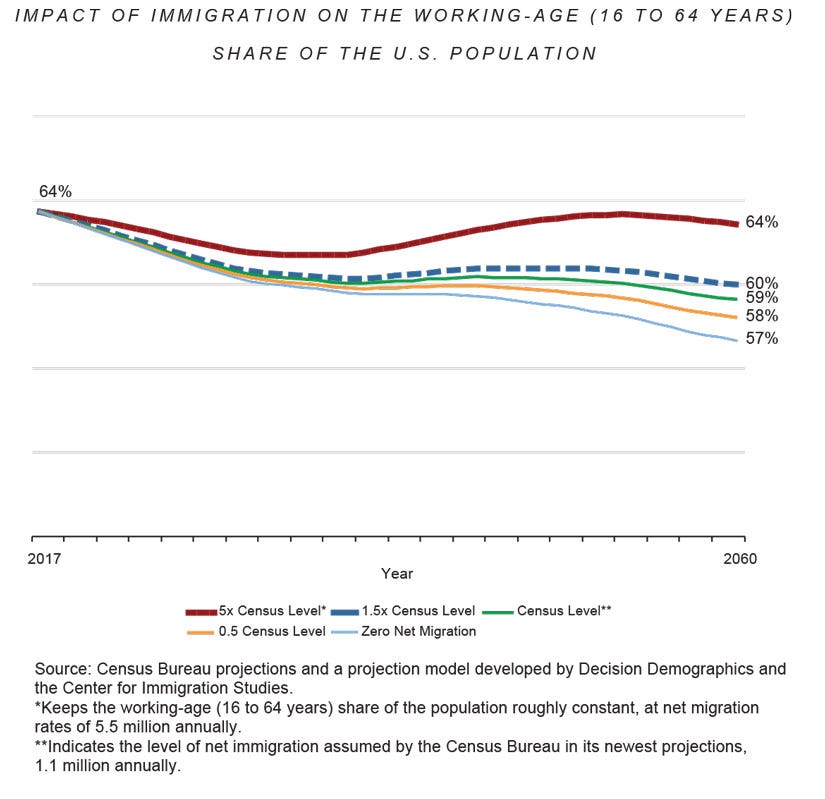
The picture for the European Union is similar. The difference in age-dependency ratios between zero non-EU immigration and existing levels is tiny: 118:100 vs 114:100 in 2060. By comparison, the 2015 level is 76:100. The total effect of all non-EU immigration on aging means that instead of this ratio increasing by 55% over 45 years, it will increase by 50%.

Because immigrants age, trying to keep age-dependency ratios constant this way is a fool’s errand. This can reach farcical levels; maintaining 1995 South Korean age-dependency ratios would require about 100 million immigrants… per year, for a total of 5.1 billion by 2050. Needless to say, there are not 5.1 billion people on Earth who want to move to South Korea and would be as productive as the average South Korean there, which is the hidden premise all proposals of using immigration to address age-dependency ratios rely on. I doubt there are even 5.1 million4.
Astute readers might notice that I’ve been careful to use the term “age-dependency ratio” rather than “dependency ratio.” Dependency ratios are not actually about age, they’re about productivity. Children and the elderly are much less able to take care of themselves. But being old or young is not the only way to be unproductive.
Fiscal Effects: Paying the Pensions
The most immediate problem caused by population aging is that almost every wealthy country, and some middle income countries such as Brazil and Argentina, are paying large and growing fraction of GDP as pensions (or equivalents like Social Security) for the elderly. Italy, which by virtue of not having much of a Baby Boom is one of the most aged countries in the world, currently leads the pack among major countries at 16.3% of GDP. This requires high levels of growth-stifling taxation, lower living standards for workers, and greatly reduces the state’s fiscal room to maneuver in case of war or emergency.

Democracies naturally tend towards vote-buying, and paying off current voters with the earnings of future generations who cannot vote is a winning strategy. This often creates a Ponzi scheme wherein huge fractions of state budgets are dedicated to redistributing the earnings of current workers to retirees in ways that depend on an ever-growing number of workers to be sustainable. Productivity gains don’t usually help, because the expected living standards of retirees, often enforced by law, increase with productivity.
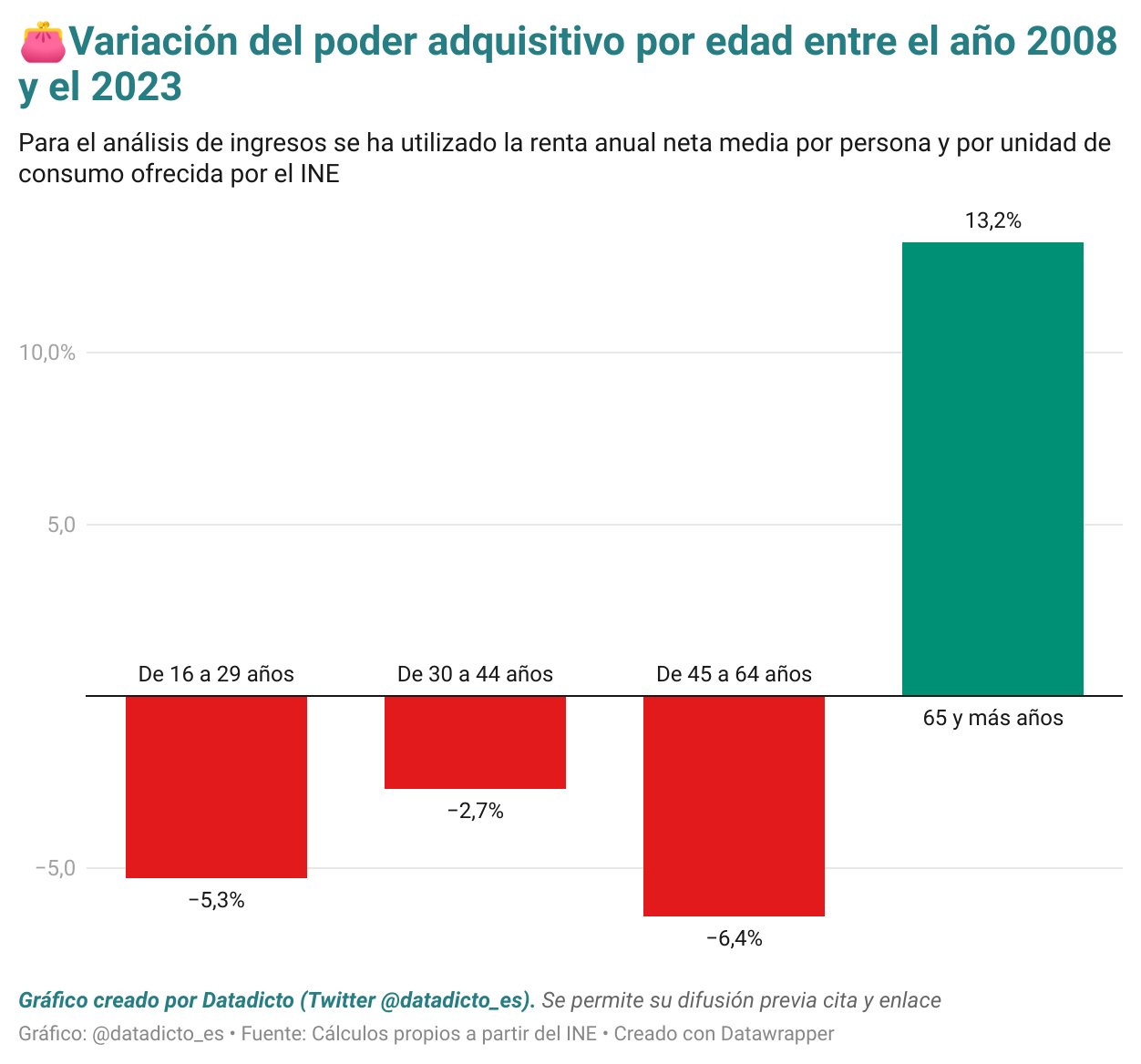
As countries age due to longer life expectancies and sub-replacement fertility, these costs spiral upwards. All of this is compounded by high elderly voting rates and the increasing elderly fraction of the population, which makes reform extremely politically costly—even Vladimir Putin had trouble raising the retirement by a few years to compensate for Russia’s increasing life expectancy.
Direct Fiscal Effects
The solution embraced by most European and Anglosphere governments has been to ameliorate population aging via immigration to keep pension costs manageable. We’ve already seen that immigration doesn’t do much for population aging, but there’s an even simpler reason why this doesn’t work: immigrants and their children are a fiscal cost, not a benefit. This is clearest in Denmark, which keeps very precise individual-level records of public benefits used and taxes paid.

While other countries don’t have publicly-available data this granular, simple models of taxes paid and benefits used show that the same pattern exists in the Netherlands, the United Kingdom, Belgium, France, Germany, Sweden, Norway, Finland, Spain, Portugal, Italy, and Austria. Every developed country in the world has a progressive taxation system and substantial redistribution via the welfare state. The precise threshold depends on the country, but in general you need to have above-median (60th to 80th percentile) lifetime earnings to be a fiscal null for the state, and above that (in the US, 90th percentile) to be a significant positive. Immigrants, who on average have lower IQs and worse local language skills than their native counterparts, tend to be low earners when they work at all. This gets worse in the second generation, as better language skills and cultural assimilation are more than compensated for by greater eligibility for benefits and the costs of education.
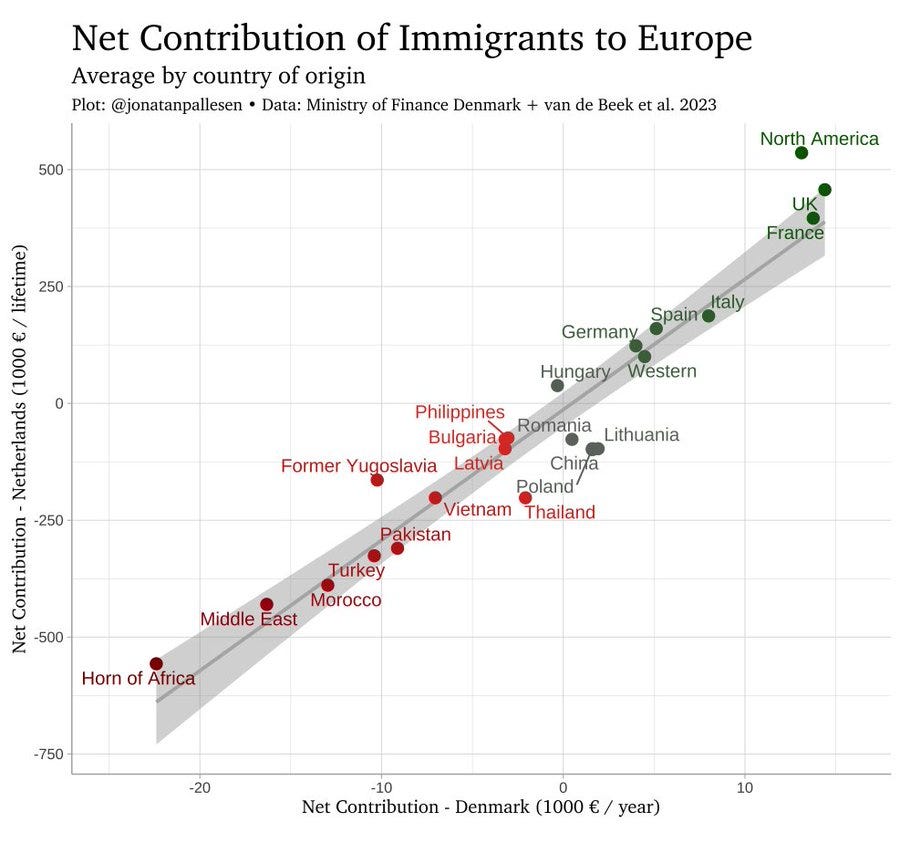
It’s often claimed that this only applies in Europe, and that in America, the median immigrant is a fiscal positive thanks to the US’s looser labor market laws, smaller welfare state, the English language, and better sources of immigrants (Mexicans being more productive than Muslims, and non-Latin American immigration being strongly positively selected on education). But it’s not true. The US, by virtue of its very progressive taxation system, is actually more redistributive than European welfare states, not less.
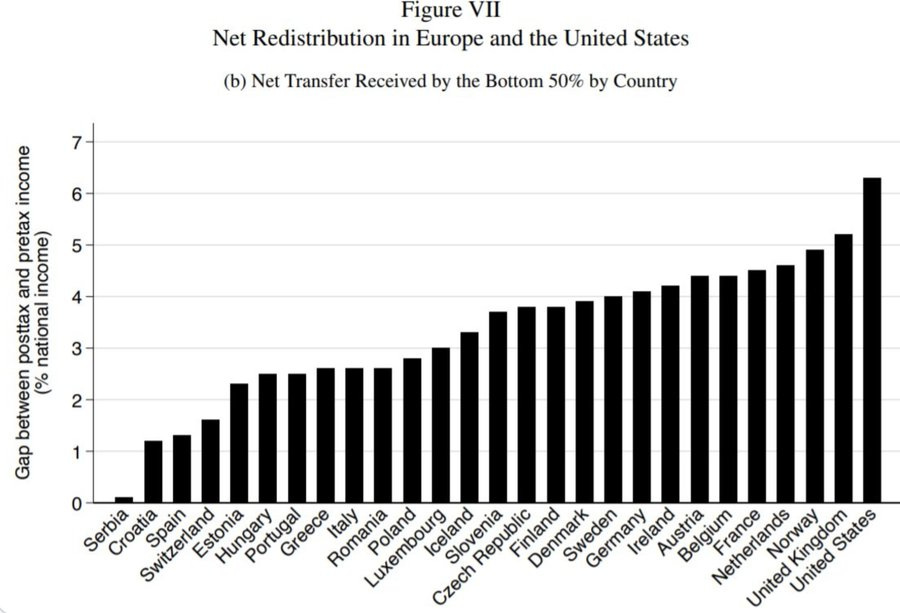
This means low earners are even more of a fiscal drag in the US than in Europe. The median immigrant household56 uses more welfare programs and earns less than the median American household; if the median immigrant household were a fiscal positive this would imply the median American household is a fiscal positive. Given the colossal size of the budget deficit, this is clearly not true.
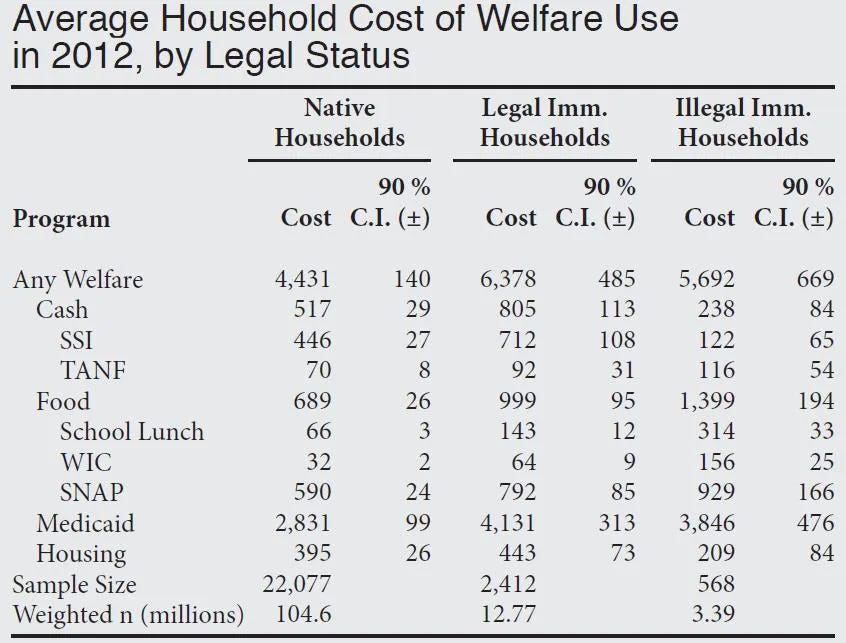
Unlike with Europe, it’s not obvious if immigration as a whole is a fiscal positive or negative for the United States (because the US system is so progressive, one software engineer can pay for a lot of fruit pickers, to say nothing of Elon Musk), but the median and marginal immigrant, which are what matter for policy, are certainly negative. Trying to fix a budget deficit with immigration is like trying to cure dehydration by drinking sea water.
Indirect Fiscal Effects
There’s the more sophisticated claim that, while immigrants are direct fiscal negatives, they have indirect positive effects that outweigh them. For instance, if five Mexicans become construction workers, this frees up the Americans they replace to become managers or white collar workers, thereby earning more money, paying more taxes, and compensating for the drain. Likewise, the median Somali household in the Netherlands may cost the state a million euros over the course of their lifetime, but the new economic opportunities opened up by their presence will more than compensate for that. This is plausible in the abstract, but doesn’t hold in practice. Gregory Cochran lays out the intuition:
Imagine a country with an average IQ of 100, some average amount of education (with some distribution), some average amount of capital per head (with some distribution of ownership of capital). Now add immigrants – 10% of the population – that are the same in every way. Same average IQ, same distribution of IQ, same average amount of capital and same distribution. They speak the same language. They have similar political traditions. In other words, it is as if the US had just peacefully annexed an imaginary country that’s a lot like Canada.
Would the original inhabitants gain economically from this merger? Strikes me that this could only happen from economies of scale – since nothing has changed other than a 10% increase in overall size. There might be some diseconomies of scale as well. I wouldn’t expect a big payoff. Except for Nawapa, of course.
Contrast this with a situation in which the extra 10% is fairly different – lower average IQ, much less education on average, don’t speak English. They don’t bring along a lot of capital. They have and bring along their native political traditions, like everyone, but theirs stink. I can easily see how those immigrants might have improved their economic lot but it’s kind of hard to see how bringing in people with low human capital benefits the original citizens more than bringing in people with considerably higher human capital. Yet it must, because adding more of the same clearly has a small effect, while adding in lower-skilled must have a big positive effect. Practically all the economists say so.
In other words, the idea of large allocative benefits from immigration is a special case of the general benefits of a larger market: more opportunities for specialization, more competition, more capital, more innovation (which scales easily) and so on. But when we look at the world, there’s no connection between country population and living standards. People understand this intuitively; no one is really shocked that Iceland (population: 396,000) or New Zealand (population: 5,252,000) are far wealthier than India (population: 1,459,153,000). In practice, ideas and goods cross borders easily (reducing the importance of internal market size), and the minimum population size required for the specialization needed for a modern economy is small.

If adding additional Swedes to Sweden would not make the existing Swedes more productive and less dependent on the state, the same should be expected of adding Syrians.
Political Effects
All of these analyses essentially “assume the system,” that is, that the benefits, spending, and tax structure of society is fixed (this is a very common error in economics, because precisely predicting system change is so difficult). But all Western countries have open political systems where foreigners can naturalize, then vote, run for office, and become activists, bureaucrats, lawyers, judges, journalists, and professors. In other words, they can change the system.
Consider the 1880-1924 steamship-driven Ellis Island immigration wave from Southern and Eastern Europe to the United States. At the time, the US had virtually no welfare state, and these immigrants were 100 IQ whites of similar ability to ethnic Americans. Fiscally speaking, this should have been a slam-dunk for the United States government, and indeed it was—initially.
But the Ellis Island wave powered both the 1932 New Deal (which was far more radical than what FDR ran on and as left-wing as the US would bear at the time) and even more importantly, Lyndon Johnson’s Great Society, durably shifting America’s political spectrum leftwards to this day. These initiatives, particularly Medicaid and the Medicare and Social Security expansions of the Johnson administration, are responsible for modern America’s fiscal woes.

Unsurprisingly, given the persistence of traits, a huge influx of European migrants Europeanized the American political system, shifting it from one based on limited government and sectional politics to a more European social democracy based around left/right ideological politics.

Given the convergence of the United States and Europe over the course of the 20th century, this may seem trivial today, but it did not at the time. In the words of Senator David Reed, defending the Immigration Act of 1924:
There has come about a general realization of the fact that the races of men who have been coming to us in recent years are wholly dissimilar to the native-born Americans, that they are untrained in self-government — a faculty that it has taken the Northwestern Europeans many centuries to acquire.
Thoughtful Americans have been despondent for the future of our country when the suffrage should be exercised by men whose inexperience in popular forms of government would lead them to demand too much of their Government, and to rely too heavily upon it, and too little upon their own initiative.
Notably, this only began to have a major effect on politics in 1928 with Al Smith’s (the first Roman Catholic nominee for US president) nomination, after immigration was cut off, because it took decades for non-English speaking, often non-citizen immigrants to be integrated into the US political system. If a researcher in 1920 were to do a simple fiscal analysis of this immigration wave of the sort that shows modern immigration is a large fiscal negative, they would’ve found it was positive. But the direct effects were dwarfed in the long run by the indirect political effects because the immigrants and their descendants had the power to change the system, and did. As seen with Senator Reed (or H. P. Lovecraft), this was both predictable and predicted ahead of time, but could not have been precisely modeled until it happened.
With that in mind, in which Western countries do immigrants and their descendants support left-wing parties that want to expand state spending? All of them.

And looking at partisanship actually understates the true effects, because as the median voter becomes more in favor of spending, anti-spending parties have to change their views to remain competitive.
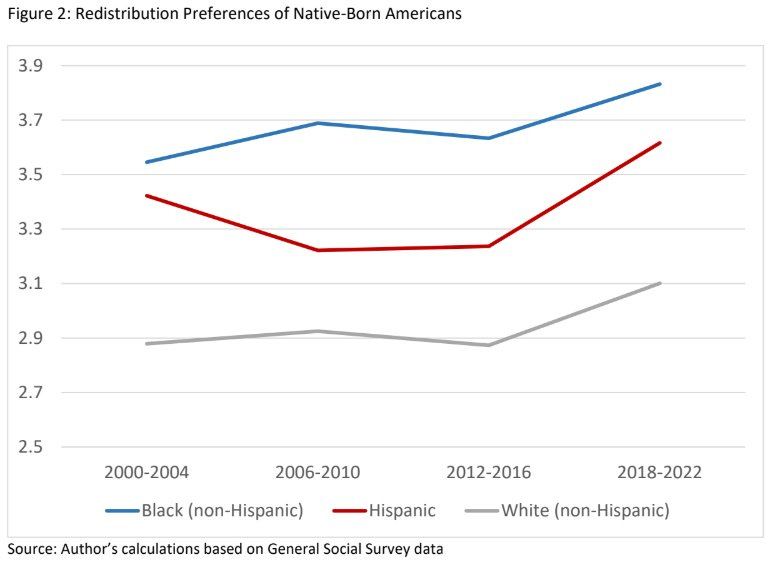
Because the political effects of immigration shift the system itself to spend more in the long-term7, direct analyses of current fiscal effects within the existing framework are a very loose lower bound for the true fiscal impact of immigration.
Living Standards
Even if immigration is fiscally costly, maybe the allocative benefits of a larger labor force and the innovative benefits of more brains will raise living standards. If this were true, you would expect to see internal migration within countries towards concentrations of immigrants8. In fact, you would expect this even if the true effect of immigration on living standards9 were null because the same economic factors that draw immigrants also draw internal migrants. But this isn’t what you see. Whether at the province, city, or neighborhood level, when immigrants move in, natives leave.

You would also expect to see mass immigration from the First World to the Third, to take advantage of the allocative benefits of low-skill labor. Someone who might be a cashier in the US could move to Brazil and enter the upper-middle class. But instead, we see Third World elites moving to the First. Why? The simple answer is that national IQ is the strongest predictor of GDP per capita10, and, conditional on GDP per capita, of future economic growth. It is also a strong predictor of almost every other thing you would guess contributes to standard of living.
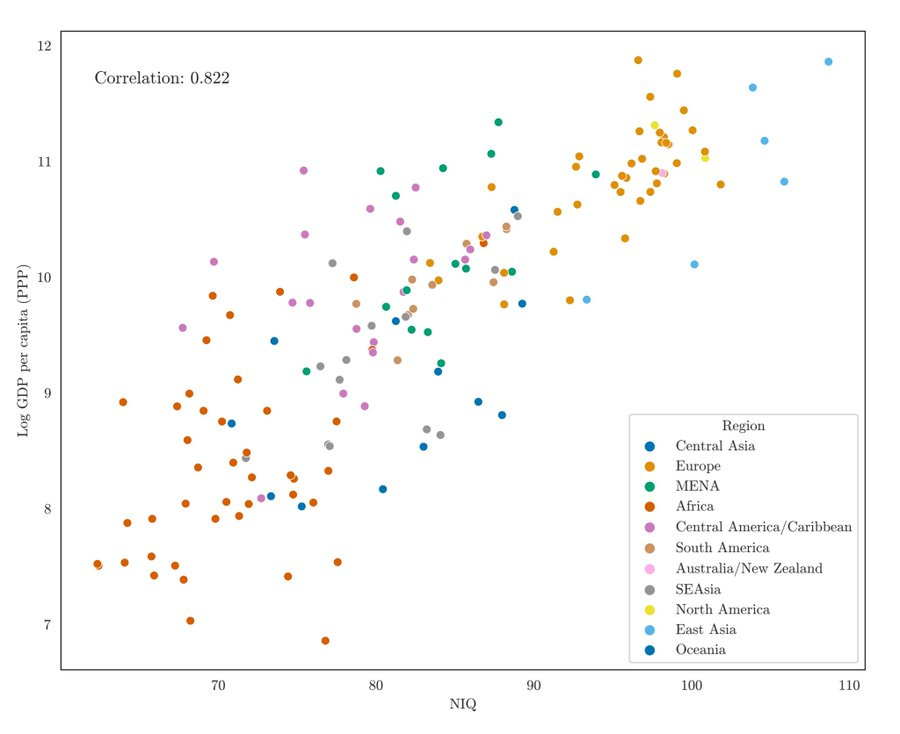
There are several mechanisms at work here. More intelligent people are more competent and capable of carrying out a given role effectively, better at innovation, better at cooperating with each other, and better at understanding economic thinking and market logic11. The result is that the effect of national IQ on national income is several times larger than the effect of individual IQ on individual income (each IQ point is associated with a 1-2% increase in individual income vs a 6-8% increase in GDP per capita). In other words, high intelligence has large positive externalities and low intelligence large negative externalities.
With that in mind, immigration lowers national IQ in every Western country except Australia.

This should be expected to be the default outcome of immigration. If:
In a post-Malthusian world without central planning, the main determinant of economic development is the characteristics of the population (of which IQ is the most easily measurable and provably important, but not the only one).
These characteristics are persistent and differences don’t disappear with cultural assimilation (they are, because like almost all human traits they are substantially genetic).
Immigrants generally move for economic reasons, and thus from poorer to wealthier countries.
Then you would expect immigration to impoverish the destination countries, unless there is strong positive selection (sufficient to overcome both regression towards the mean and the gap between populations), which in a world of cheap and easy transportation requires heavy restrictions12.
National Power
Foreigners will generally be apt to bring with them attachments to the persons they have left behind; to the country of their nativity, and to its particular customs and manners - Alexander Hamilton.
Against the insidious wiles of foreign influence, (I conjure you to believe me fellow citizens) the jealousy of a free people ought to be constantly awake; since history and experience prove that foreign influence is one of the most baneful foes of Republican Government - George Washington.
Another argument is that a higher population is needed to “beat China” (“beat at what” is usually left unsaid) or otherwise increase the geopolitical power of the state (eg “immigration is America’s superpower13”). The idea is that a larger population means a larger (absolute) economy and military, and therefore more heft on the international stage, and so immigration is in the interests of the state even if it isn’t in the interests of the citizenry. This is implicitly a “citizens-as-subjects” perspective.
I reject this frame (states exist to serve us, not the other way around), but even taking it for granted, what this misses is that the realist view of the state is wrong. States are not unitary actors pursuing the instrumentally-rational objective of power (the national interest). They are ruled by the needs of domestic politics, and immigration produces special interests that make foreign policy in the interest of the nation difficult. The classic example of this is Florida Cubans14. The US cannot have a foreign policy towards Cuba based on the US national interest because of the large and electorally influential Cuban diaspora. Multiply this across every world region and both state- and non-state conflicts and you get state paralysis. This is one of the biggest reasons the American founders were skeptical of (at the time, exclusively European) immigration; they didn’t want American policy determined by foreign interests. This was a prescient concern; the governments of China, India, and Mexico all openly view their diasporas as tools to influence the politics of other states.
Even more importantly, internal conflict is incredibly debilitating. States that are insufficiently united against outsiders are playgrounds or battlefields for foreign powers, not actors in their own right. The classic example15 here is China during the Century of Humiliation. China possessed an enormous and competent population, but was impotent against much smaller, but more cohesive, foreign powers (even Japan, which did not have a technological advantage during the first Sino-Japanese war). One of the most reliable findings in all the social sciences is that ethnic diversity causes social conflict, and that the more different different groups are, the more conflict. Ethnic conflict is not the only source of internal division, but it is an unusually important and persistent one, which is why homogeneity is invaluable for any state. Influence abroad depends on unity at home.
When times are good, ethnic conflicts can be brushed under the rug, but when things fall apart, homogenous nation-states rise from the ashes while multiethnic conglomerations fracture and disappear. There is a reason why the nation-states of Central and Eastern Europe and East Asia emerged from the titanic cataclysms and disasters of the World Wars16 and the fall of Communism, while the Russian Empire, Austria-Hungary, the Ottoman Empire, the Soviet Union, and Yugoslavia fell to pieces and are confined to the dustbin of history. And when national power is a priority, there is a reasonable expectation things might go wrong.
Furthermore, how much a state can gets out of its people depends on how legitimate those people see it as. The rule in modern Western countries is that no matter how welcomed or privileged they are, minorities view the state as a hostile and foreign imposition, while the state-forming ethnic group is demoralized by losing their country. Britain is the extreme case of this (famously, more British Muslims joined ISIS than the British Army), but in 2021 58% of US whites considered themselves very patriotic, while only 37% of blacks, 36% Hispanics, and 28% of Asians did.
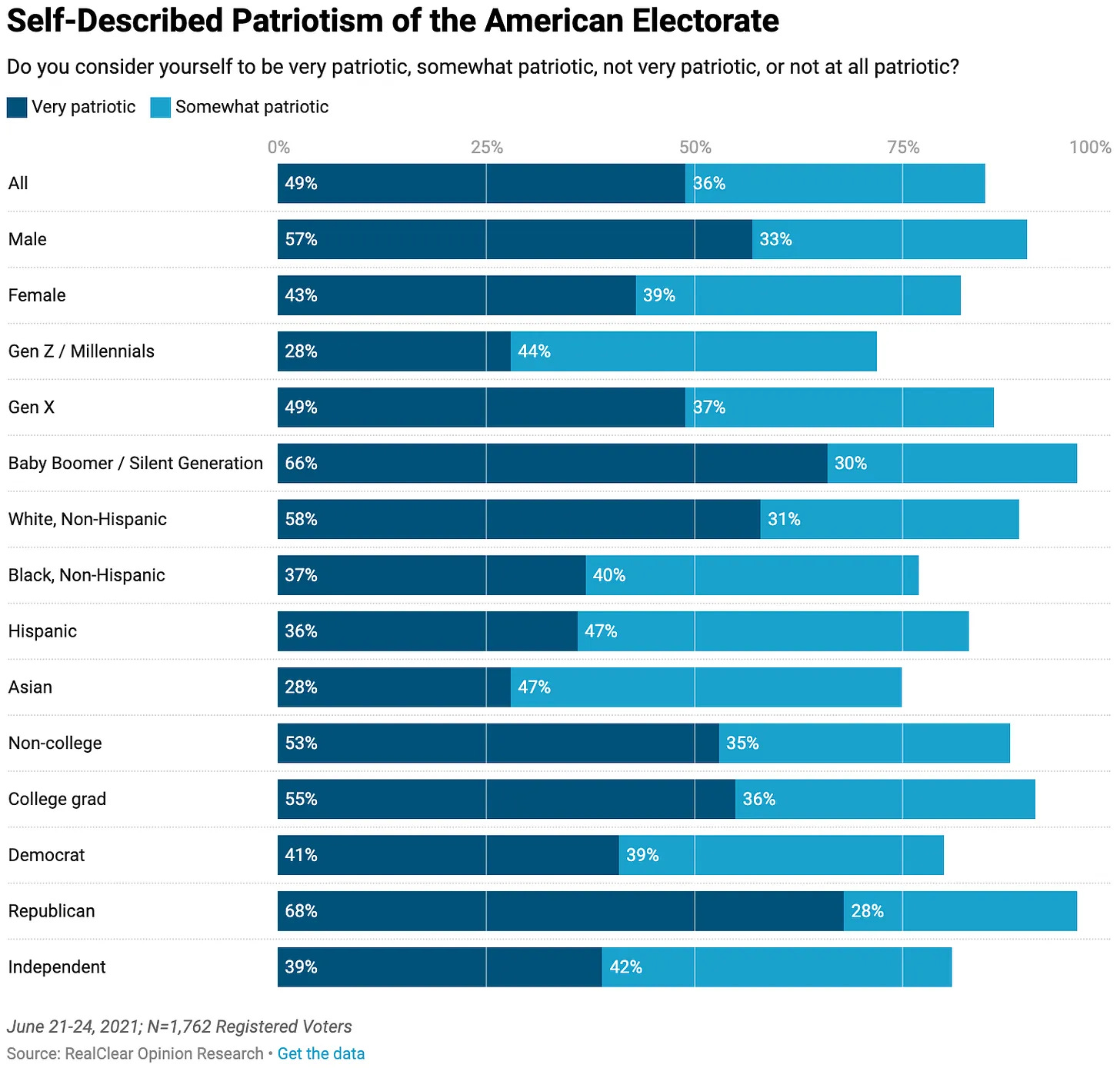
Lastly and most importantly, the point of national power is to stop hostile foreigners from taking your stuff and taking power over you. The traditional way to lose power to hostile foreigners is military force, but if they’re just given visas, military strength is irrelevant. From the rhetoric of immigrant intellectuals in the US to the constant terror attacks in Europe to the horrific anti-white Pakistani rape-gangs of Britain17, it’s clear that a large swathe of actually-existing immigration is no different from an invasion where we have chosen to surrender without a fight18.
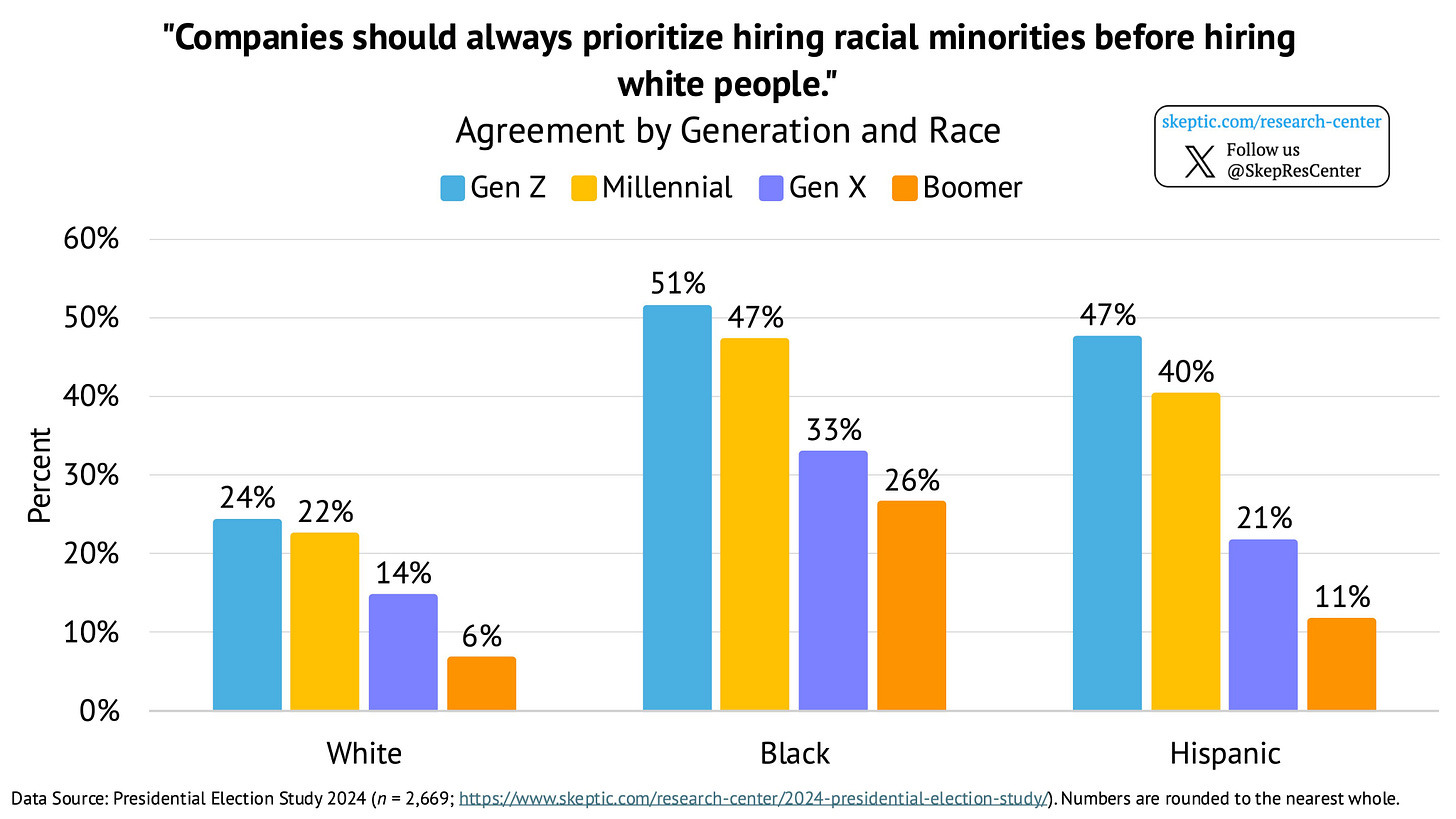
Using actually-existing immigration to prop up the power of the state is like the parable of the two economists who paid each other $1000 to eat shit (increasing GDP by $2000). You’re increasing a certain measure of wealth (GDP)/national power (population size), but forgetting that the purpose of wealth is to improve our lives and the purpose of the state is to protect us.
Ethnic and Personal Continuity
When writing about fertility I and many other writers tend to frame things in terms of living standards or national power, as these are easily legible to a broad audience. But this is not how people usually think of their own children. People usually want children for their own sake, as a link in a chain stretching from the past to the future. From a Darwinian perspective, this is clearly adaptive. Public pronatalism is a tremendously inefficient way to do this on personal level, but still has a place, because no matter how many children you personally have, your own children will regress towards the communal mean. Outside of insular religious groups, this means the nation as a whole.
Immigration makes personal continuity marginally19 harder. There are two big reasons. First, immigration increases experienced population density and drives up housing prices, both of which reduce fertility. Second, no matter what the population of your country or city, the number of people you personally know will be about the same, as will the number of people you will interact with by default (coworkers, classmates, and so on). Assortative mating is the rule, meaning that the less like you (i.e. the more diverse) this fixed-sized social circle is, the harder it will be to find a husband or wife2021.
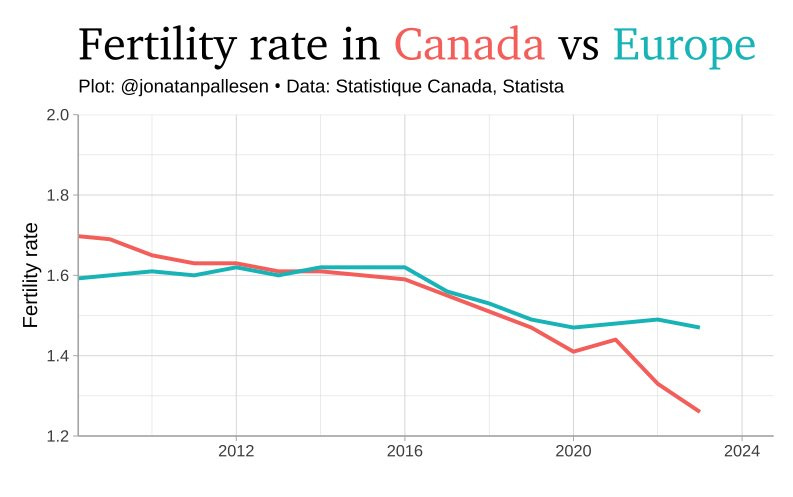
And as with personal continuity, people care about ethnic continuity for its own sake. They do not like the idea that, even if their genes may be propagated into the future, their culture and collective identity will vanish. There are both cultural/historical reasons (groups that did not instill mechanisms of propagation/group-feeling into their members did not survive to the present), and Darwinian ones (individuals without collective entities to back them up and support their interests get predated on by more cohesive groups) for this.

And actually-existing immigration is a much bigger threat to ethnic continuity than low fertility. Low fertility alone can only destroy very small ethnic groups, like the Parsis, completely in the near term (generations). On current trends, there will still be 70 million Japanese (the most aged country in the world) by 2100, and that leaves centuries for another wild fertility swing to turn things around before extinction. Mass migration is much faster. Everywhere in the West with mass immigration there’s a constant drumbeat of “anyone can be X,” “X is a nation of immigrants,” and “X does not exist,” all sentiments denying that the boundaries of a group and therefore both its existence and capacity for collective interests and action. The institutions and thus means of group-reproduction of titular ethnic groups are asymmetrically opened to the world.
This is even more true on a genetic level; without strong legal or social (such as religion or language) barriers against intermixing (which do not exist) physical proximity guarantees the disappearance of genetically-distinct ethnic groups (in animals, this is known as genomic extinction). This can happen fast; a simple simulation based on existing rates of fertility and intermarriage in the US today show that >95% white individuals will nearly disappear within four generations assuming immigration is not stopped.

Note that essentially the entire population becomes admixed, despite significant racial preferences. This is because mixed individuals are more attractive to unadmixed ones than their unadmixed opposite-race equivalents would be. The classic example of this is Latin America, especially the Southern Cone and Brazil, which are majority-European genetically and saw significant post-colonial European immigration, but have almost no unadmixed whites today. Historically, the US avoided this with the One Drop Rule, with even slightly admixed individuals classified socially as black, preventing this sort of gradual introgression, which is why the average non-Hispanic US white today is 99.8% European genetically. Genomic extinction means the permanent loss of both the physical and mental traits that underly culture and distinguish ethnic groups22. If saving the white rhino or bowhead whales from extinction is a good thing, why not Italians or Germans or Americans or the English or the Irish, all threatened by mass immigration23?
Conclusions
Modern day mass immigration does little to slow population aging, worsens government’s fiscal situations, lowers living standards, has at-best ambiguous effects on national power, and threatens personal and ethnic continuity. It is no more a solution to population decline than defunding tax collection is a solution to government deficits. But this doesn’t mean the problems of population decline go away. Some actual solutions include:
Hoping technological advances bail us out. The Great Stagnation is real and “ordinary” productivity advancements won’t cut it, but something like anti-aging, AGI,24 or biosingularity25 would.
The Japanese solution. This means more retirees working and lower pensions. Japan is often framed as a cautionary tale against the dangers of xenophobia, but this is 20 years out of date. Since 2008, high-immigration Western Europe and the ultra-high immigration non-US Anglosphere have both stagnated badly. Growth among advanced economies has mostly been either catch-up growth by high-IQ post-Communist ethnostates with net-negative migration (Eastern Europe and above all China) or the United States, which is why there is a negative correlation between economic growth and population growth among advanced economies in the 21st century. For all its problems, Japan has cheap housing in desirable areas, sophisticated industry and exports, a unique and world-beating national culture, and levels of public order lost 60 years ago in the West. There are worse fates. Barring a technological miracle or higher fertility, the options on offer are not stagnation and homogeneity vs immigration and dynamism, they’re Japan vs Lebanon.
Raising birth rates. I’ve written about this elsewhere. This would work, though there would be a generation or so of pain where a small number of adults would have to support large numbers of both seniors and children.
“We need immigration because of low birth rates” is a rhetorical zombie that needs to die. Do not let innumerate and ignorant commentators get away with it.
It is not prima facie obvious that population decline per se is bad. Fewer people means more land per person, less environmental pollution caused by human activity (for fixed living standards), and that the capital investments of the past, whether that be roads, factories, or above all houses can be shared between fewer people. There are good reasons overpopulation used to be a major fear, though I think this sentiment is misguided today outside of Africa, South Asia, and the Middle East.
I specify “actually-existing immigration” because there is no such thing as Immigrasia. The concerns in this article do not apply to all immigrants or all possible forms of immigration, but they do apply to the ones we actually have, right now, in the real world.
By comparison, labor force participation rate for the working-age population is 78.1% in the United States (vs 83% in Canada and 89.2% in Sweden), meaning there’s ample scope to achieve a 2% increase with zero immigration (OECD). To the extent immigration reduces workforce participation rates by making certain jobs low-status and lowering wages, it may even reduce the working fraction of the population.
This gets even worse if you look to the future. Latin America and India are below replacement fertility; the only sources that will keep increasing into the mid-century are Africa and the most backwards part of the Muslim world. Even if the demographic Ponzi scheme worked in the short term (it doesn’t), we would only be kicking the can down the road.
It’s important to look at the household, not the individual, as the unit, because these programs are usually claimed on behalf of citizen children. The same applies to other costs like education. An extremely common rhetorical trick used by immigration boosters is to put this spending in the “native” column, which makes the “native” column look worse and the “immigrant” column look better. But these people being citizens and eligible for programs and education is a result of immigration. The costs of native-born children of immigrants need to be included as costs of immigration in any serious analysis. Governments that rely on these projections reliably end up with both a lot more immigration and a lot more debt.
An even dirtier trick, as seen here by the Cato and the Manhattan Institute, is to pretend military, welfare, and entitlement spending is fixed and not related to immigration (or total GDP or government revenue, which are increased by larger population size), thereby putting these massive costs in the “native” column and removing the largest costs from the “immigrant” column. If you ignore by far the largest sources of government spending and everything after the first generation, immigration looks fiscally great. This has no relation to reality.
Richard Hanania and the Cato institute have argued that, by reducing social trust, diversity actually reduces redistribution. Setting aside the question of whether or not a society where people hate and distrust each other is worth lower redistribution (note: there is a strong positive correlation between social trust and GDP per capita, and good reason to believe this is causal in both directions as it allows people to do things like hire unrelated employees or not expensively inspect every single shipment for fraud), this is factually wrong. Main effects dominate diversity effects; the direct effect of adding more redistribution-happy immigrants to the population vastly outweighs the indirect effect of making natives slightly more opposed to redistribution. And even granting the premise, immigration doesn’t stop at the “hormetic dose” required to make the natives oppose redistribution. The more immigration, the more special interests, including the immigrants themselves, that benefit from it and the harder it is to stop, and folk-socialist immigrants quickly overwhelm marginally more right-wing natives. See: California.
In fact, you do see this with some historical examples. Cities in Germany that hosted Huguenot refugees attracted more internal migration and grew faster than those didn’t, because the Huguenots brought rare and valuable skills and were not especially objectionable to the Germans. When I say “immigrants,” I’m referring to modern-day immigration in aggregate unless otherwise specified. An immigrant is just someone who relocates across national borders, not a coherent group of people, and there’s tremendous variation within that extremely broad category.
Note: Living standards are much broader than GDP per capita or personal incomes, though they are highly correlated. Some things not captured by those two measures include physical safety, noise levels, infrastructure quality, and the language of local signs, all of which impact quality of life (this list is not exhaustive). I think trying to enumerate, weigh, and precisely measure everything that goes into living standards is a fool’s errand, but you can look at people’s revealed preferences to see how they move.
I’ve seen the argument that even if low IQ immigration reduces GDP per capita, every individual is still better off (because you’re adding a poor person, but nobody’s income is reduced). Refer to the previous argument about internal mobility; if this were true “white flight” and equivalents wouldn’t be such a universal phenomenon.
Economists like Bryan Caplan and Garret Jones often bemoan the ignorance of the American electorate, which believes that building more housing will increase the price and implicitly that public spending is free, and blame this for bad policy. Now imagine the policies of a country where the electorate has 10 fewer IQ points. We could call it “Bexico.” Further, assume that we have the option of letting millions of “Bexicans” into the state of California. What would the effect on California’s government be expected to be?
No one has any problem with this argument if you frame it in an immigration-positive way, like looking at the effects of European immigration to Brazil, or if you frame it in a way flattering to left-wing sensibilities, like pointing out the negative long-term effects of the African slave trade.
Putting this in a footnote because it’s not an argument, just a vibe, but I get the sense that the people who make this argument envision themselves as court viziers standing at the head of a vast imperium, for whom the glory of the state is of paramount concern and citizens are (implicitly) subjects whose purpose is to serve the Leviathan. I strongly disagree with this viewpoint; the state should exist for the benefit of individuals and not the other way around. India has more geopolitical power than Iceland, but I claim Iceland is the superior society. And even if we allow that Iceland can remain sovereign purely thanks to a generous United States-backed security architecture, the “minimum viable state” for defense against outsiders in the nuclear age still only requires a white or East Asian population in the millions; think Cold War Israel or apartheid-era South Africa or North Korea (operating at a tiny fraction of what it’s capable of thanks to central planning).
The Israel Lobby, Dearborn Arabs and Palestine, and the US’s shameful treatment of our greatest ally Britain during the Troubles thanks to diaspora Irish support for the IRA are other examples that immediately come to mind.
But far from the only one; the Polish-Lithuanian Commonwealth, the Holy Roman Empire, and 100 Years War France also come to mind.
Worth emphasizing: Germany lost a quarter of an entire generation of men (sex ratio among Germans 25-49: 0.77 in 1950), had most of its cities bombed flat, a quarter of the country occupied by the Soviets and separated from the rest, and lost all foreign assets after WWII. 20 years later, and Germany was the wealthiest large country in Europe and second wealthiest in the world (after the US), with a strong military, and the world’s fourth largest economy. Japan is similar. Nation-states can bounce back quickly even from epochal disasters.
Also note the cheering on of these rape gangs by non-Pakistanis. I came across this example today. It’s impossible to argue with a straight face that you need to welcome people cheering your replacement and mass gang rape for the national interest.
Some instructive quotes from immigrant youth robbers in Sweden, via Inquisitive Bird. “When we're downtown robbing, we're fighting, we're fighting against the Swedes!” Another says: “Power to me is that the Swedes must look at me, lie down on the ground, and kiss my feet.” They view Swedes, who have given them refuge, privileges, welfare, and a far better society than they ever could have built, as enemies to be defeated and humiliated.
I don’t want to exaggerate the effect size here; it’s real but homogeneity doesn’t solve low fertility or even come close. Sex relations are far more important.
Even if you, personally, are a rabid xenophile, most of your prospective partners are not.
A recent study claims that racial diversity explains 20-44% of US fertility decline since 1970, and that this mechanism is responsible. I think this number is too high and driven by unmeasured confounding (specifically, by political leftism/secularism/urbanism), but that the direction of the effect is still real.
In the case of whites, it also means the loss of the far-right tail of intellectual and non-intellectual-mental ability, which is absolutely essential for scientific accomplishment. Given the overwhelming importance of whites (and the irrelevance of Latin America, the best point of comparison) to science both historically and today, this would cripple science, perhaps permanently. But this is a race-specific argument; people value ethnic continuity for its own sake, not just because ethnic groups have unique strengths.
A caveat here is that, in cases where groups are genetically indistinguishable, true assimilation does happen. This is why internal migration from Germanophone Switzerland to lower fertility Francophone Switzerland didn’t historically threaten the latter; a child of Germanophone Swiss who speaks French and is acculturated to Francophone norms is indistinguishable from other Francophone Swiss. This strengthened the Francophone Swiss as a group and helped keep linguistic proportions constant within Switzerland. Much historical European immigration to the US or France is similar. But as with the Huguenots from before, this does not apply to modern day immigration in the aggregate.
There are a lot of ways for this to go wrong, whether that be the classic MIRI scenario of a misaligned singleton superintelligence tiling the universe with some alien goal, or the Hanson/Land scenario of a return to Malthusianism due to trivial reproduction leading to everything human ground away to nothing in the crucible of perfect competition (see also: Gradual Disempowerment), or the Intelligence Curse scenario of a handful of AI elites and/or institutions that no longer have any need for humans killing, disempowering, or impoverishing everyone else. But humans becoming irrelevant does have the advantage of human problems, such as low fertility and population decline, becoming irrelevant.
Biosingularity, as the name implies, is the biological analogue to AI singularity. Rather than smarter machines that design smarter machines that design smarter machines, you have smarter humans coming up with more effective ways to increase human intelligence. To take the politically and technologically (it already exists) easiest effective method, Gwern has calculated that simple embryo selection for IQ could improve IQ by about 10 points per generation. This is a much slower (generational) and much safer (many parents have children smarter than them right now, and it generally works out fine for both parents and children. Trying to improve IQ by 10 standard deviations in a generation would probably cause problems, but <1 standard deviation per generation keeps things within-distribution) process than an AI singularity.
All of the problems except continuity mentioned in this article are obviated by +10 IQ points per generation. A country that did this would see rapid economic growth and improvement in living standards and national power even with a declining population (imagine Brazil turning into Germany in a single generation). Embryo-selected IVF already exists and has been used; the limiting factor is the low power of existing polygenic scores for intelligence and health. The easiest way for a government to promote this would be funding the creation of large sample size (millions) high-quality polygenic scores for intelligence, health, and other desirable traits.



This is outstanding, rational commentary. Thank you for the effort you’ve committed to writing this post.
Great article! Information packed and factually dismisses the ridiculous assertions made by blank statists. Thank you.